
It’s hard to tell, but behind the beautiful, glimmering greens and blues of the Northern Lights hides a world of violence. The colorful glow of the Auroras (also known as the aurora borealis or polar lights) is the result of particles from the sun releasing energy as they bombard Earth’s atmosphere. Most frequently seen in the skies of high-latitude regions around the Arctic and Antarctic, the auroras appear as a diffuse glow or as a luminous curtain-like shape, sometimes forming relatively static arcs or flowing, nebulous shapes known as “active aurora.” These auroras have even been known to glow intensely enough to allow observers to read newsprint at night.
While this gorgeous light show includes a variety of colors, including greens, reds, and blues, the auroras also contain many types of ultraviolet and infrared auroral radiation that are invisible to the human eye. And while the phenomena of the auroras are attributed to disturbances in Earth’s magnetosphere caused by solar wind, our understanding of the physical processes that lead to different types of auroras is still incomplete.
In an effort to shed light on these processes, scientists from the United States, Norway, Japan, Canada, and other countries launched The Grand Challenge Initiative, a series of missions tasked with studying the polar cusp. These missions will specifically study the flow of winds in Earth’s upper atmosphere and the interactions of Earth’s magnetic field with the protons and electrons that bombard our planet daily. The Auroral Zone Upwelling Release Experiment (AZURE) is one of the missions targeting the ionosphere, the electrically charged atmospheric layer that lies 46 to 621 miles above Earth.
On April 5, two rockets launched from Norway’s Andoya Space Center, deploying chemical tracers that ionize in sunlight, enabling researchers to track the flow of neutral and charged particles in the auroral wind. These tracers (trimethylaluminum and a barium-strontium mixture) are helping NASA analyze the vertical winds that mix electrically charged particles and energy through the atmosphere and measure the winds' density and temperature.
The tracers were deliberately conspicuous: For half an hour, the northern Norway sky boasted an impressive lightshow of colorful clouds, dots, and plumes composed of ionized particles whose movement was tracked by NASA.
“Not a lot of the locals knew what was going on, and since it looked like an alien invasion there was a lot of publicity in the press,” explains Dr. James Hecht from Aerospace’s Ionospheric and Atmospheric Sciences Department.

Aerospace designed and built the two rocket-mounted, three-channel photometers used to measure auroral emission profiles in the ionosphere.
“Aerospace’s photometers are designed to measure photons and different colors of light,” Hecht explains. “When we measure light emitted by an aurora, we can get a 2D profile of atmospheric composition.”
While detailed examination of the data is still ongoing, all indications are that the photometers on both rockets worked well. Data derived from the Aerospace photometers used for this mission will be coordinated with the winds derived from the chemical releases and with ground-based wind measurements, leading to an improved understanding of auroral processes. Researchers hope this data helps lead to a better understanding of the contribution that auroras make to the total amount of energy that enters and leaves Earth’s geospace system, thus providing the key to overcoming difficulties faced by radio communications and remote sensing in high-latitude regions.

